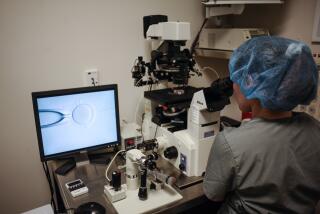Fix the Job, Not the Worker : Labor: If industries are allowed to bar fertile women from ‘dangerous’ jobs, similar restrictions by race and ethnicity may follow.
- Share via
The notion that women must be sterilized if they want to work at certain industrial jobs seems bizarre, something from a fictional, despotic foreign nation. Not in the United States, surely.
Wrong.
A federal appeals court has ruled that employers may bar all women of childbearing capacity from factory jobs if the job might be hazardous to a fetus. The bar applies whether or not women are pregnant, intend to get pregnant or are likely to get pregnant.
Other courts have rejected this approach, but the new decision is likely to encourage many employers simply to close their doors to women workers. Or women will have choose between fertility and employment.
The case involves an automobile battery-making operation in which lead is used. Workers and their union filed a sex-discrimination case claiming that it is unjustifiable to bar women since lead is equally harmful to both sexes, most women workers will not become pregnant and workplace health risks should be reduced or eliminated by making the workplace safer. After all, that’s what happened when toxic chemicals like DBCP made men sterile--the chemical was banned, not the worker.
The appeals court rejected this approach in a decision that has broad implications. According to dissenting judges, women could be excluded from 20 million industrial jobs. For unskilled women, such jobs may provide the only escape from poverty.
Because they cannot afford to give up their jobs, many of these women may feel forced into sterilization. This has already happened and it’s likely to get worse. With heavy financial responsibilities for children or elderly parents, some women will not have a choice.
Employers with these policies claim that adult workers are safe at certain exposure levels, but that no exposure is safe for a fetus. To reach this conclusion, such employers often ignore the findings of federal health and safety agencies and rely instead on the testimony of industry-funded scientists. There is ample evidence that workers of both sexes exposed to lead face health risks ranging from adverse effects on sperm (possibly affecting future generations) to neurological damage and cardiovascular disease. Frequently, however, employers pick and choose among studies demonstrating lead’s harmful effects to find the ones they like, usually those focusing on pregnant women.
Fear of liability for fetal injury is often cited as a justification for excluding women workers, but the concern should extend equally to both sexes. In fact, claims on behalf of the children of male workers outnumber those filed for children of women employees.
And companies that handle toxic substances face potential lawsuits from an array of sources, not just workers. Toxic chemicals can spill in transport, leak from disposal sites or escape into surrounding air or water. The children of male as well as female workers may sue, alleging that a parent’s workplace exposure caused genetic injury.
If employers can identify fertile women as potentially “hyper-susceptible,” then simply eliminate them to make the workplace “safe,” all sorts of discriminatory possibilities open up.
Some employers claim that certain genetic conditions that disproportionately affect racial or ethnic groups can be exacerbated by toxic exposures. Will they require genetic testing of all workers to identify those who are genetically “hypersusceptible”? Will they then seek to bar workers on the basis of race or ethnic origin in order to protect them or their offspring?
Employers who bar women would sacrifice the interests of living children and adults for questionable gains for potential fetuses. When women encounter reproductive (or other) risks at work, they usually worry about them a lot more than the boss does. And they certainly are better equipped to decide whether they should stay, request a transfer or leave.
More to Read
Inside the business of entertainment
The Wide Shot brings you news, analysis and insights on everything from streaming wars to production — and what it all means for the future.
You may occasionally receive promotional content from the Los Angeles Times.










